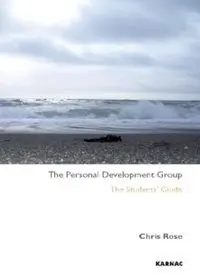
The Personal Development Group: The Students' Guide PDF
Preview The Personal Development Group: The Students' Guide
122 2 3 4 5 6 7222 THE PERSONAL DEVELOPMENT GROUP 8 9 10 1 2 3 4 5222 6 7 8 9 20 1 2 3 4 5 6 7 8 9 30 1 2 3 4 5 6 7 8 922 i ii 122 2 3 4 5 6 72 THE PERSONAL 8 9 10 DEVELOPMENT 1 2 GROUP 3 4 5222 The Students’ Guide 6 7 8 9 20 1 Chris Rose 2 3 4 5 6 7 8 9 30 1 2 3 4 5 6 7 8 922 KARNAC iii First published in 2008 by Karnac Books Ltd 118 Finchley Road, London NW3 5HT Copyright © 2008 by Chris Rose The rights of Chris Rose to be identified as the author of this work have been asserted in accordance with §§ 77 and 78 of the Copyright Design and Patents Act 1988. All rights reserved. No part of this publication may be reproduced, stored in a retrieval system, or transmitted, in any form or by any means, electronic, mechanical, photocopying, recording, or otherwise, without the prior written permission of the publisher. British Library Cataloguing in Publication Data AC.I.P. for this book is available from the British Library ISBN-13: 978–1–85575–535–2 Edited, designed, and produced by Florence Production Ltd, Stoodleigh, Devon www.florenceproduction.co.uk Printed in Great Britain www.karnacbooks.com iv 122 2 3 4 5 6 7222 CONTENTS 8 9 10 1 2 3 ABOUT THE AUTHOR vi 4 5222 ACKNOWLEDGEMENTS vii 6 1 Why “personal development”? 1 7 8 2 Getting on board 14 9 20 3 Setting off 27 1 2 4 Learning to row 39 3 5 Undercurrents 51 4 5 6 Singing and sailing 63 6 7 7 Conflict 75 8 9 8 Underlying division and difference 88 30 9 Ways of understanding 101 1 2 10 Authority 114 3 4 11 Putting it into practice 127 5 6 12 Coming to the end 142 7 BIBLIOGRAPHY 153 8 922 INDEX 155 v ABOUT THE AUTHOR Chris Rose is a psychotherapist and group analyst working in private practice, the NHS and the higher education sector. She has many years experience in the training of counsellors and psychotherapists, as teacher, group facilitator, supervisor, course director and staff consultant. Her interests lie in the relationship between group and individual, in language and communication, and in gender and social class. Her current work looks at the development of self-reflexivity, and she has published articles in Therapy Today and Group Analysis. vi 122 2 3 4 5 6 7222 ACKNOWLEDGEMENTS 8 9 10 1 2 3 4 5222 The experiences and ideas that have inspired this book have come 6 from many different groups of students, trainers, counsellors, 7 psychotherapists, patients and clients. Every group member and 8 facilitator has made a contribution, and I am grateful to all of them 9 for the part they have played in shaping this book. The characters 20 in the vignettes, however, are fictitious, created from a mixture of 1 experience and imagination. 2 The training courses at City College Coventry, Birmingham 3 University, Solihull College, Coventry and Warwick University, and 4 the Turvey Centre for Group Psychotherapy have all, in different 5 ways, contributed to the writing of this book. 6 Some of the ideas have developed out of articles that I have 7 written for the BACP publication, Therapy Today and its predecessor, 8 The Counselling and Psychotherapy Journal. I would like to thank the 9 editors, Sarah Browne and Eleanor Fitzpatrick, for their support 30 and encouragement, as well as Anne Doyle, Sandra Harrison and 1 Richard Worsley. 2 3 4 5 6 7 8 922 vii viii 122 CHAPTER ONE 2 3 4 5 6 7222 Why “personal development”? 8 9 10 1 2 3 4 5222 hy should counsellors and psychotherapists spend time 6 and effort in looking at their own attitudes and behavi- 7 Wours? Their work will revolve around others, not them- 8 selves, so what is the point of this self-examination? Would it not be 9 better to spend the time learning more about other people, or 20 developing useful skills and techniques? 1 These are questions that never go away, because each new 2 generation of counselling and psychotherapy trainees has to find 3 their own answers. They will be given a variety of ready made 4 answers from their particular brand of training, but in the end, they 5 have to make up their own minds. They will have to choose where 6 to position themselves on a spectrum that extends from the “white 7 coat” to the “intersubjective” model. At one end, therapeutic change 8 is achieved by skilled intervention from a qualified expert. At the 9 other, change comes about through meaningful contact between 30 human beings. 1 Any sort of therapy that values the relationship between the client 2 and the therapist/counsellor has to look at both ends of the rela- 3 tionship. If therapeutic change is the outcome of a relationship 4 between two or more people, then it is neither logical nor ethical to 5 suppose that the person labelled the therapist is a neutral ingredient. 6 How we are as people affects the relationships we have with those 7 we work with. This is the fundamental idea that underpins this 8 book. 922 1
